kidney & bladder support
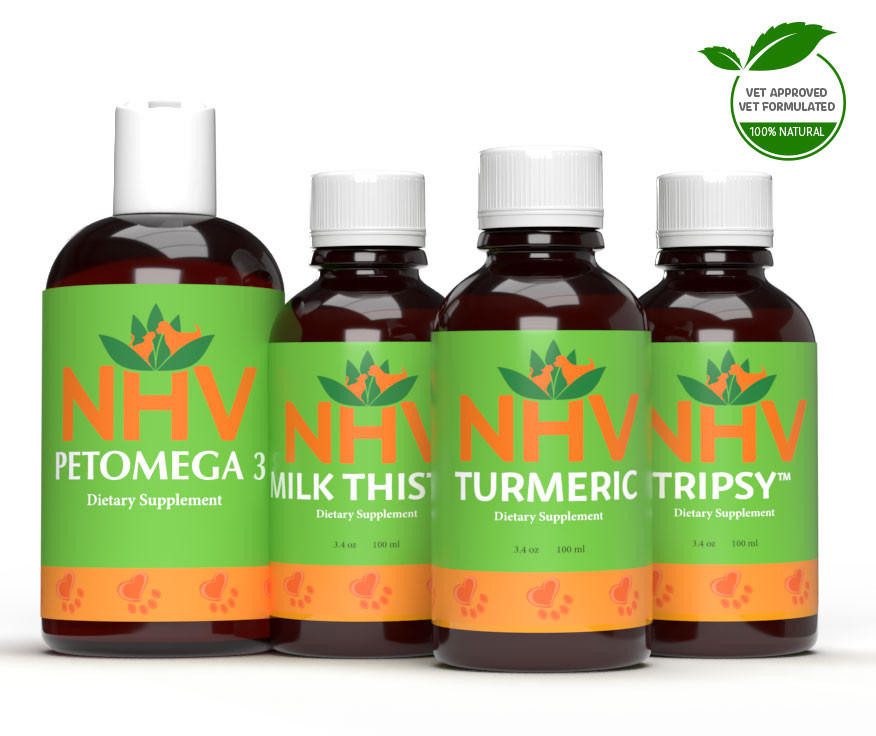
free shipping over $100 (USA & Canada)
1-877-937-4372 the pet expert hotline
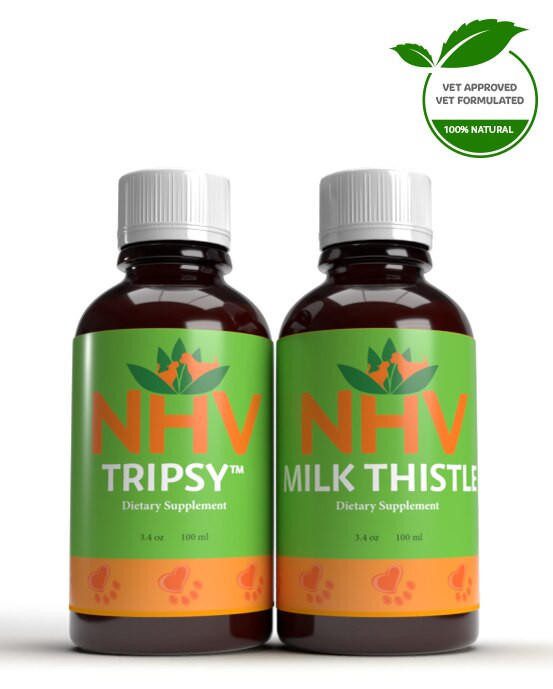
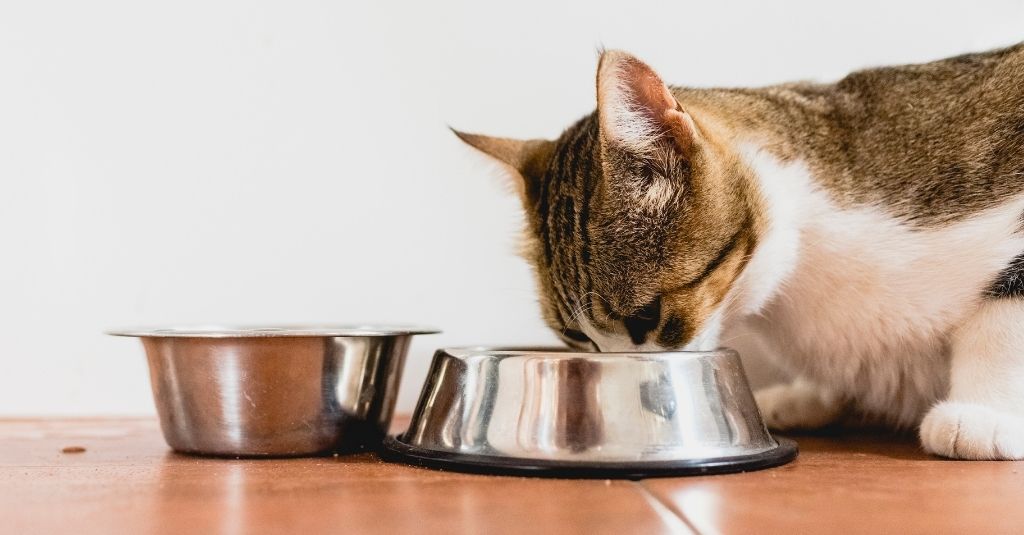
Chronic Kidney Disease (CKD) is one of the most common conditions in elderly dogs and cats, although it can appear at any age. Finding the right diet for pets with kidney disease is an important part of managing this condition.
Chronic kidney disease is characterized by abnormalities in kidney function and/or structure. The first clinical signs that your furbaby may have CKD are an unexplained increase in water intake, resulting in an increase in urination (and the pee becomes very clear, looking like water) and loss of appetite.
Unfortunately, CKD is one of the most common causes of death in cats and dogs. Usually, the pet shows the clinical signs only when approximately 75% of renal capacity is compromised. The diagnosis is based on some of the values seen in blood work (creatinine, urea, and urinary density) that give some clues about the health of the kidneys.
CKD is a progressive disease but can be managed with dietary changes associated with other measures (pharmacological and/or homeopathy, acupuncture, ozone therapy, nutraceutical medicine, etc.).
Creatinine levels are evaluated based on the classifications from the International Society of Renal Interest –IRIS, and can tell us if the pet’s diet needs to be changed for a “renal-friendly diet”.
A renal-friendly diet is built to meet the pet’s nutritional and energy requirements and at the same time minimize the clinical signs.
It is the most important change, as it is able to slow the progression of the disease. Some authors state that phosphorus dietary restriction is the therapeutic intervention that should have priority. According to the IRIS recommendation, the supporting food should be used in patients in stages II, III, and IV of CKD since from stage II on, most animals start to present hyperphosphatemia (increased levels of phosphor).
A diet that is low in phosphorus may increase the life expectancy of the pet by approximately two and a half times, compared to a pet who received a diet without this restriction. A study has shown that only 33% of the animals that received a diet that is low in phosphorus had renal complications, while pets that received a diet that did not have phosphorus restriction, the number of deaths due to renal complications reached 65%. The data from this study shows that phosphorus restriction is extremely important in pets with CKD. It is also important to point out that phosphorus restriction is essential to decrease the risk of Secondary Renal Hyperparathyroidism, common in pets with CKD.
Moderate restriction and highly digestible protein with low mineral content are recommended. This strategy allows the reduction of nitrogenous residues and phosphorus, without causing protein or amino acids deficiency.
Adequate amino acid intake is extremely important to prevent cachexia (weakness and wasting of the body due to severe chronic illness), especially in cats, which are carnivores. Moderate protein restriction can decrease the risk of uremia (high levels of urea in the blood) and reduce proteinuria in pets with CKD.
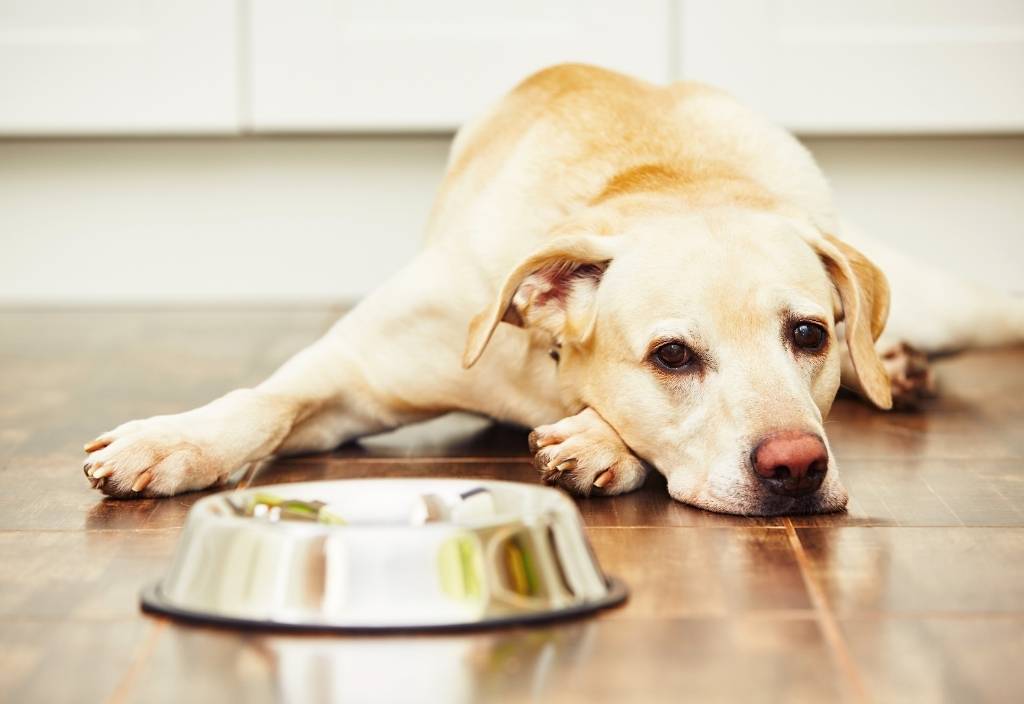
It is important that the diet contains high energy density, as loss of appetite is quite common in pets with CKD. The use of non-protein sources of energy is interesting because in this way the protein is saved to maintain the body mass. Some source of fat, for example, present in some types of fish, is an excellent source of energy for cats and dogs, in addition to increasing palatability to food.
Supplementing the diet with omega 3 fatty acids (eicosapentaenoic acid [EPA] and docosahexaenoic acid [DHA]) has an interesting role in renal physiology, as they promote the reduction of the inflammatory process.
NHV Petomega 3 is a human-grade quality fish oil that is naturally rich in omega 3 fatty acids. Petomega 3 is made from the oils of sardines, anchovies, and North Atlantic cod. It’s an excellent source of EPA and DHA and is molecularly distilled and cold-pressed to improve bioavailability.
Although the main means of treating systemic arterial hypertension (high blood pressure in the arteries) is medication, sodium levels should be normal to moderately reduced. Studies suggest that curcumin supplements may promote the dilation of blood vessels, increasing blood flow and reducing blood pressure.
Antioxidants and vitamins, especially of the B complex, must be provided via diet. Antioxidants are important for reducing oxidative stress from chronic injury, and reducing disease self-progression. Due to the presence of polyuria (excessive urination), polydipsia (excessive thirst), and vomiting in CKD cases, the loss of water-soluble vitamins is great. NHV Multi Essentials is an excellent source of antioxidants and vitamins.

A wet diet helps to keep the pet hydrated and also helps the kidneys to eliminate the toxins. A homemade diet would be the best. However, there are many wet food options commercially available for pets with CKD.
Pets with CKD often experience appetite loss and easily get tired of eating the same food. So, if you are okay cooking for your pet, you can change the recipes for one that pet will enjoy and entice them to eat.
Thus, the use of supplements formulated for renal support such as Tripsy and Milk Thistle have an important place in the management of this disease. They may contribute to the maintenance of renal function by delaying the evolution of the disease, contributing to the improvement of the quality of life, and increased life expectancy in significantly affected pets.
If you need help ensuring that your pet battling CKD has a balanced diet that is right for their condition, I offer personalized nutrition plans. These nutrition plans include recipes and a guide on how to cook meals balanced for your pet’s specific needs at home.
If you have any questions about your pet’s condition or diet, our team of pet experts is here to help. Click the chat button below to start chatting with us now.
kidney & bladder support

Tripsy, Milk Thistle, Turmeric & PetOmega 3
bundle and save with pet expert kits
Support your pet through kidney disease or kidney failure with all-natural supplements formulated to support organ function and help with symptoms.

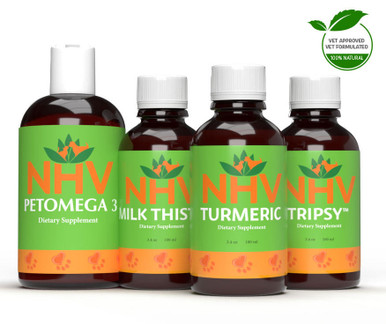
Support your pet through kidney disease or kidney failure with all-natural supplements formulated to support organ function and help with symptoms.

Powerful Support for Your Dog or Cat
Kidney issues can be really hard on pets and pet parents. The signs that your cat or dog is suffering from kidney disease or kidney failure include lethargy, weight loss, dehydration, frequent urination, and vomiting. Supporting your pet’s kidneys with gentle all-natural supplements can help them with symptoms of kidney disease and help improve their quality of life.
How NHV Remedies Provide Kidney Support for Cats and Dogs
NHV’s Kidney Support Kit for dogs and cats is used to help pets with moderate to severe chronic kidney disease and kidney failure by flushing the kidneys of impurities and improving kidney function.
The four supplements in this comprehensive kit support the kidneys in several important ways. The Omega 3 fish oils in PetOmega 3 have excellent anti-inflammatory properties, specifically for the kidneys. Omega 3 fatty acids also help reduce proteinuria (protein lost from the kidneys expelled through the urine).
Milk Thistle has strong antioxidant and detoxifying properties that may help promote cellular regeneration, repair the liver, and offer extra support to the kidneys.
Turmeric has an outstanding list of helpful benefits as an anti-inflammatory, antioxidant, antifungal, antibacterial, antiseptic, and astringent.
Tripsy™ is NHV’s main kidney support supplement. It has been studied at the University of Georgia for its potential benefits for pet health. It contains even more beneficial herbal ingredients, including Stone Root, Parsley Piert, and Gravel Root that help prevent the formation of kidney stones (kidney calculi).
Powerful Comprehensive Benefits
Order the NHV Kidney Support Kit for Dogs and Cats to provide comprehensive support in addition to their vet-recommended treatment.
PETOMEGA 3 - Omega 3 Fatty Acids are beneficial to the kidneys. This medical-grade fish oil is derived from sardine, anchovy, and North Atlantic cod liver oil. It is molecularly distilled and cold-pressed to improve the bioavailability.
MILK THISTLE - Organic Milk Thistle Seed to naturally detoxify, strengthen, and rejuvenate the liver and kidneys.
TURMERIC - An extract with natural anti-inflammatory, antioxidant, antibacterial, and antiseptic properties to support healthy kidneys.
Select your pet's weight to determine the correct dose.
PETOMEGA 3 DOSAGE : Pet’s Weight Dosage
0-15 lb = ¼ tsp
15-30 lb = ½ tsp
30-60 lb = 1 tsp
60-90 lb = 1 ½ tsp
TRIPSY, TURMERIC, MILK THISTLE DOSAGE : To be taken twice daily. Determine your pet’s weight and then use the easy chart below to determine the correct dose. This is the minimum dosage.
Pet's Weight Dosage
0 - 15 lb = 0.5 ml
16 - 30 lb = 1.0 ml
31 - 45 lb = 1.5 ml
46 - 60 lb = 2.0 ml
61 - 75 lb = 2.5 ml
Over 75 lb = 3.0 ml
For small animals (rabbits, ferrets), avians and reptiles use 1 drop for every 2 lb of body weight.
How to Administer
Shake well before use. The easiest method is to use the dropper provided and place the drops into your pet’s food or favorite treat. You can also use the dropper and squirt directly into the pet’s mouth. Some pets can be finicky, if this occurs consider hiding the drops in foods most pet’s love such as fish, chicken or yogurt or a favorite treat. If your pet only eats dry food then soak a few kibbles at feeding time.
For Best Results
Herbal dietary supplements are beneficial to the health and well-being of your pet and are safe for long-term use. Every pet responds to natural herbal supplements differently, therefore it is important to be consistent and administer the product daily. Supplements generally take two to four weeks to take effect, however this will vary from one animal to the next.
Product Storage
All NHV Natural Pet Products are pure herbal extracts and contain no artificial additives, preservatives or coloring. Shelf life after opening is 6 months and must be refrigerated after opening.
Cautions and Contraindications
Do not use in pregnant or nursing animals.
All information provided by NHV Natural Pet Products is for educational purposes only.
Powerful Support for Your Dog or Cat
Kidney issues can be really hard on pets and pet parents. The signs that your cat or dog is suffering from kidney disease or kidney failure include lethargy, weight loss, dehydration, frequent urination, and vomiting. Supporting your pet’s kidneys with gentle all-natural supplements can help them with symptoms of kidney disease and help improve their quality of life.
How NHV Remedies Provide Kidney Support for Cats and Dogs
NHV’s Kidney Support Kit for dogs and cats is used to help pets with moderate to severe chronic kidney disease and kidney failure by flushing the kidneys of impurities and improving kidney function.
The four supplements in this comprehensive kit support the kidneys in several important ways. The Omega 3 fish oils in PetOmega 3 have excellent anti-inflammatory properties, specifically for the kidneys. Omega 3 fatty acids also help reduce proteinuria (protein lost from the kidneys expelled through the urine).
Milk Thistle has strong antioxidant and detoxifying properties that may help promote cellular regeneration, repair the liver, and offer extra support to the kidneys.
Turmeric has an outstanding list of helpful benefits as an anti-inflammatory, antioxidant, antifungal, antibacterial, antiseptic, and astringent.
Tripsy™ is NHV’s main kidney support supplement. It has been studied at the University of Georgia for its potential benefits for pet health. It contains even more beneficial herbal ingredients, including Stone Root, Parsley Piert, and Gravel Root that help prevent the formation of kidney stones (kidney calculi).
Powerful Comprehensive Benefits
Order the NHV Kidney Support Kit for Dogs and Cats to provide comprehensive support in addition to their vet-recommended treatment.
PETOMEGA 3 - Omega 3 Fatty Acids are beneficial to the kidneys. This medical-grade fish oil is derived from sardine, anchovy, and North Atlantic cod liver oil. It is molecularly distilled and cold-pressed to improve the bioavailability.
MILK THISTLE - Organic Milk Thistle Seed to naturally detoxify, strengthen, and rejuvenate the liver and kidneys.
TURMERIC - An extract with natural anti-inflammatory, antioxidant, antibacterial, and antiseptic properties to support healthy kidneys.
Select your pet's weight to determine the correct dose.
PETOMEGA 3 DOSAGE : Pet’s Weight Dosage
0-15 lb = ¼ tsp
15-30 lb = ½ tsp
30-60 lb = 1 tsp
60-90 lb = 1 ½ tsp
TRIPSY, TURMERIC, MILK THISTLE DOSAGE : To be taken twice daily. Determine your pet’s weight and then use the easy chart below to determine the correct dose. This is the minimum dosage.
Pet's Weight Dosage
0 - 15 lb = 0.5 ml
16 - 30 lb = 1.0 ml
31 - 45 lb = 1.5 ml
46 - 60 lb = 2.0 ml
61 - 75 lb = 2.5 ml
Over 75 lb = 3.0 ml
For small animals (rabbits, ferrets), avians and reptiles use 1 drop for every 2 lb of body weight.
How to Administer
Shake well before use. The easiest method is to use the dropper provided and place the drops into your pet’s food or favorite treat. You can also use the dropper and squirt directly into the pet’s mouth. Some pets can be finicky, if this occurs consider hiding the drops in foods most pet’s love such as fish, chicken or yogurt or a favorite treat. If your pet only eats dry food then soak a few kibbles at feeding time.
For Best Results
Herbal dietary supplements are beneficial to the health and well-being of your pet and are safe for long-term use. Every pet responds to natural herbal supplements differently, therefore it is important to be consistent and administer the product daily. Supplements generally take two to four weeks to take effect, however this will vary from one animal to the next.
Product Storage
All NHV Natural Pet Products are pure herbal extracts and contain no artificial additives, preservatives or coloring. Shelf life after opening is 6 months and must be refrigerated after opening.
Cautions and Contraindications
Do not use in pregnant or nursing animals.
All information provided by NHV Natural Pet Products is for educational purposes only.
kidney & bladder support
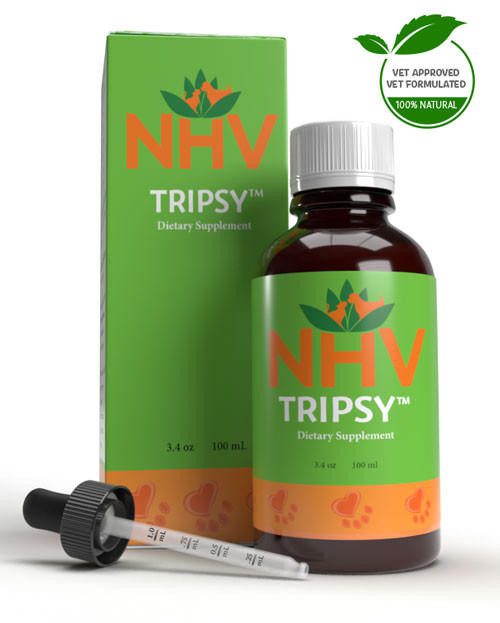
Supplement for kidney, renal and bladder problems in cats
buy 2 and save $3
3 month supply for a small to medium size

Specially formulated to gently and effectively promote proper urinary health as well as easing uncomfortable urination that often accompanies kidney problems in cats. With seven powerful ingredients, this supplement is highly effective in helping your cat’s urinary system.
NHV Tripsy for kidney problems in cats also helps to:
Many cats can suffer from kidney, renal and urinary disorders that can be uncomfortable. Kidney stones form when the body is unable to properly metabolize minerals due to a poor diet. If untreated, this may eventually lead to kidney failure, so making sure your feline family member gets adequate nutrition is vital.
NHV’s Tripsy is also safe to be given along with conventional treatments for kidney problems in cats. You can read about a recent evaluation done on the healing components of this powerful supplemental blend and how it alleviates bladder problems in cats.
Finding the right blend of kidney supplements for cats is easy online at NHV. If you have questions or concerns, you can always schedule a consultation because at NHV we want to provide you with the best service to help your cat live a healthy purrfect life naturally.
Stone Root – Acts as a tonic for the capillaries and prevents the formation of kidney calculi.
Parsley Piert – Aids digestion. Also used to aid fever, kidney stones, bladder stones and fluid retention.
Wild Hydrangea – May help with discomfort while increasing the flow of urine and eliminating swelling and fluid retention.
Gravel Root – Restores and cleanses the genitourinary (reproductive and urinary) organs.
Echinacea Purpurea – Contains strong immune-stimulating properties.
Marshmallow – An anti-inflammatory that controls bacterial infections and soothes and softens irritated tissues.
Oregon Grape – Helps relieve indigestion and malabsorption. Also has antibiotic and immunostimulatory properties.
Select your pet's weight to determine the correct dose.
To be taken twice daily. Determine your pet’s weight and then use the easy chart below to determine the correct dose. This is the minimum dosage.
Pet's Weight Dosage
0 - 15 lb = 0.5 ml
16 - 30 lb = 1.0 ml
31 - 45 lb = 1.5 ml
46 - 60 lb = 2.0 ml
61 - 75 lb = 2.5 ml
Over 75 lb = 3.0 ml
How to Administer
Shake well before use. The easiest method is to use the dropper provide and places the drops into your pet’s food or favorite treat. You can also use the dropper and squirt directly into the pet’s mouth.
Some pets can be finicky, if this occurs consider hiding the drops in foods most pet’s love such as fish, chicken or yogurt or a favourite treat. If your pet only eats dry food then soak a few kibbles at feeding time.
For Best Results
Herbal dietary supplements are beneficial to the health and wellbeing of your pet and are safe for long-term use. Every pet responds to natural herbal supplements differently, therefore it is important to be consistent and administer the product daily. Supplements generally take two to four weeks to take effect, however this will vary from one animal to the next.
Product Storage
All NHV Natural Pet Products are pure herbal extracts and contain no artificial additives, preservatives or coloring. Shelf life after opening is 6 months and must be refrigerated after opening.
Cautions and Contraindications
Do not use Tripsy if your pet is pregnant. No known side effects. Speak to your vet before using our products. A second visit is recommended if your pet’s condition does not improve, or deteriorates after continued use of the supplements.
All information provided by NHV Natural Pet Products is for educational purposes only.
Specially formulated to gently and effectively promote proper urinary health as well as easing uncomfortable urination that often accompanies kidney problems in cats. With seven powerful ingredients, this supplement is highly effective in helping your cat’s urinary system.
NHV Tripsy for kidney problems in cats also helps to:
Many cats can suffer from kidney, renal and urinary disorders that can be uncomfortable. Kidney stones form when the body is unable to properly metabolize minerals due to a poor diet. If untreated, this may eventually lead to kidney failure, so making sure your feline family member gets adequate nutrition is vital.
NHV’s Tripsy is also safe to be given along with conventional treatments for kidney problems in cats. You can read about a recent evaluation done on the healing components of this powerful supplemental blend and how it alleviates bladder problems in cats.
Finding the right blend of kidney supplements for cats is easy online at NHV. If you have questions or concerns, you can always schedule a consultation because at NHV we want to provide you with the best service to help your cat live a healthy purrfect life naturally.
Stone Root – Acts as a tonic for the capillaries and prevents the formation of kidney calculi.
Parsley Piert – Aids digestion. Also used to aid fever, kidney stones, bladder stones and fluid retention.
Wild Hydrangea – May help with discomfort while increasing the flow of urine and eliminating swelling and fluid retention.
Gravel Root – Restores and cleanses the genitourinary (reproductive and urinary) organs.
Echinacea Purpurea – Contains strong immune-stimulating properties.
Marshmallow – An anti-inflammatory that controls bacterial infections and soothes and softens irritated tissues.
Oregon Grape – Helps relieve indigestion and malabsorption. Also has antibiotic and immunostimulatory properties.
Select your pet's weight to determine the correct dose.
To be taken twice daily. Determine your pet’s weight and then use the easy chart below to determine the correct dose. This is the minimum dosage.
Pet's Weight Dosage
0 - 15 lb = 0.5 ml
16 - 30 lb = 1.0 ml
31 - 45 lb = 1.5 ml
46 - 60 lb = 2.0 ml
61 - 75 lb = 2.5 ml
Over 75 lb = 3.0 ml
How to Administer
Shake well before use. The easiest method is to use the dropper provide and places the drops into your pet’s food or favorite treat. You can also use the dropper and squirt directly into the pet’s mouth.
Some pets can be finicky, if this occurs consider hiding the drops in foods most pet’s love such as fish, chicken or yogurt or a favourite treat. If your pet only eats dry food then soak a few kibbles at feeding time.
For Best Results
Herbal dietary supplements are beneficial to the health and wellbeing of your pet and are safe for long-term use. Every pet responds to natural herbal supplements differently, therefore it is important to be consistent and administer the product daily. Supplements generally take two to four weeks to take effect, however this will vary from one animal to the next.
Product Storage
All NHV Natural Pet Products are pure herbal extracts and contain no artificial additives, preservatives or coloring. Shelf life after opening is 6 months and must be refrigerated after opening.
Cautions and Contraindications
Do not use Tripsy if your pet is pregnant. No known side effects. Speak to your vet before using our products. A second visit is recommended if your pet’s condition does not improve, or deteriorates after continued use of the supplements.
All information provided by NHV Natural Pet Products is for educational purposes only.
multivitamin support
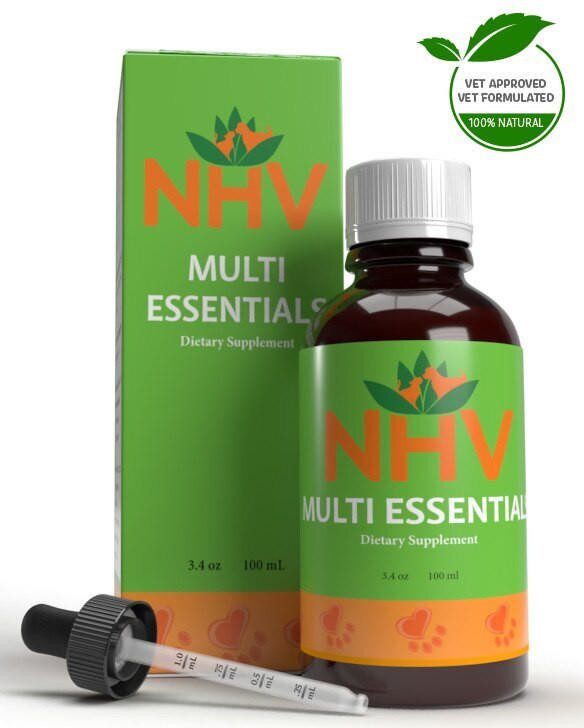
Herbal Digestive Aid, Energy Booster, and Multivitamin for Cats
buy 2 and save $3
3 month supply for a small to medium size pet
These multivitamins for cats will ensure your kitty (of any age) is getting an extra dose of minerals and vitamins for extra energy, vitality, and health.

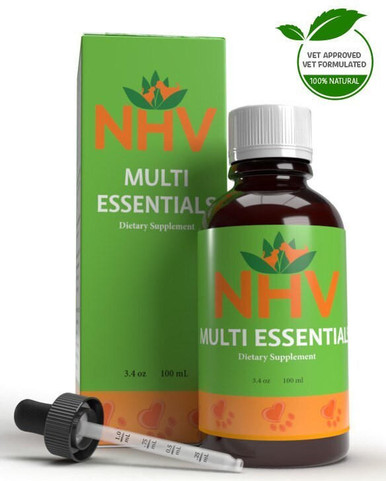
These multivitamins for cats will ensure your kitty (of any age) is getting an extra dose of minerals and vitamins for extra energy, vitality, and health.

The health benefits of multivitamins aren’t just for humans. Cats have many of the same nutrient needs as we do, and some need even more than others depending on their age and health.
A multivitamin supplies the vital nutrients your kitty needs to be healthy and to fight off potential health problems. Dr. Cook, DVM, CVA in her blog states that vitamins “help to regulate the body processes, protect the body from environmental toxins, and break down nutrients such as carbohydrates, proteins, and fats so the body can utilize them”.
The best way to give your cat vitamins and minerals are from whole food sources and not just isolated synthetic vitamins. NHV Multi Essentials contains a powerful blend of alfalfa, oat, dandelion, kelp, parsley, marshmallow, chickweed, stinging nettle, Asian ginseng, yucca and Oregon grape.
Health Benefits of NHV’s Multi-Essentials for Cats
With NHV’s multi vitamins for cats, you get a proprietary blend of all-natural ingredients that are organically grown and contain no artificial additives, preservatives, or coloring. Some of the health benefits include:
Multivitamins for cats will ensure your kitty is getting the proper nutrients that could be lacking due to daily stressors, a poor diet, and environmental toxins.
Signs of Vitamin Deficiency in Your Cat
Kitties Who’ve Benefited from NHV Multi Essentials
NHV multi vitamin for cats has helped thousands of pets around the world. Here are just a few of their stories:
DEALING WITH DIGESTIVE ISSUES: MICI THE CAT LOVES HIS VITAMINS NHV MULTI ESSENTIALS
HERBAL MULTIVITAMINS AND TURMERIC HELP CATS, OATMEAL AND MELISSA LIVE HAPPIER
CAN CATS WITH FELV LIVE A HEALTHY AND NORMAL LIFE?
If you have questions regarding holistic support including vitamin supplements for cats, ask an NHV expert because, at NHV, we want your cat to feel clawtastic naturally!
Select your pet's weight to determine the correct dose.
To be taken twice daily. Determine your pet’s weight and then use the easy chart below to determine the correct dose. This is the minimum dosage.
Pet's Weight Dosage
0 - 15 lb = 0.5 ml
16 - 30 lb = 1.0 ml
31 - 45 lb = 1.5 ml
46 - 60 lb = 2.0 ml
61 - 75 lb = 2.5 ml
Over 75 lb = 3.0 ml
How to Administer
Shake well before use. The easiest method is to use the dropper provide and places the drops into your pet’s food or favorite treat. You can also use the dropper and squirt directly into the pet’s mouth.
Some pets can be finicky, if this occurs consider hiding the drops in foods most pet’s love such as fish, chicken or yogurt or a favorite treat. If your pet only eats dry food then soak a few kibbles at feeding time.
For Best Results
Herbal dietary supplements are beneficial to the health and wellbeing of your pet and are safe for long-term use. Every pet responds to natural herbal supplements differently, therefore it is important to be consistent and administer the product daily. Supplements generally take two to four weeks to take effect, however this will vary from one animal to the next.
Product Storage
All NHV Natural Pet Products are pure herbal extracts and contain no artificial additives, preservatives or coloring. Shelf life after opening is 6 months and must be refrigerated after opening.
Cautions and Contraindications
Do not use Multi Essentials in pregnant or nursing animals. Speak to your vet before using our products. A second visit is recommended if your pet’s condition does not improve, or deteriorates after continued use of the supplements.
All information provided by NHV Natural Pet Products is for educational purposes only.
The health benefits of multivitamins aren’t just for humans. Cats have many of the same nutrient needs as we do, and some need even more than others depending on their age and health.
A multivitamin supplies the vital nutrients your kitty needs to be healthy and to fight off potential health problems. Dr. Cook, DVM, CVA in her blog states that vitamins “help to regulate the body processes, protect the body from environmental toxins, and break down nutrients such as carbohydrates, proteins, and fats so the body can utilize them”.
The best way to give your cat vitamins and minerals are from whole food sources and not just isolated synthetic vitamins. NHV Multi Essentials contains a powerful blend of alfalfa, oat, dandelion, kelp, parsley, marshmallow, chickweed, stinging nettle, Asian ginseng, yucca and Oregon grape.
Health Benefits of NHV’s Multi-Essentials for Cats
With NHV’s multi vitamins for cats, you get a proprietary blend of all-natural ingredients that are organically grown and contain no artificial additives, preservatives, or coloring. Some of the health benefits include:
Multivitamins for cats will ensure your kitty is getting the proper nutrients that could be lacking due to daily stressors, a poor diet, and environmental toxins.
Signs of Vitamin Deficiency in Your Cat
Kitties Who’ve Benefited from NHV Multi Essentials
NHV multi vitamin for cats has helped thousands of pets around the world. Here are just a few of their stories:
DEALING WITH DIGESTIVE ISSUES: MICI THE CAT LOVES HIS VITAMINS NHV MULTI ESSENTIALS
HERBAL MULTIVITAMINS AND TURMERIC HELP CATS, OATMEAL AND MELISSA LIVE HAPPIER
CAN CATS WITH FELV LIVE A HEALTHY AND NORMAL LIFE?
If you have questions regarding holistic support including vitamin supplements for cats, ask an NHV expert because, at NHV, we want your cat to feel clawtastic naturally!
Select your pet's weight to determine the correct dose.
To be taken twice daily. Determine your pet’s weight and then use the easy chart below to determine the correct dose. This is the minimum dosage.
Pet's Weight Dosage
0 - 15 lb = 0.5 ml
16 - 30 lb = 1.0 ml
31 - 45 lb = 1.5 ml
46 - 60 lb = 2.0 ml
61 - 75 lb = 2.5 ml
Over 75 lb = 3.0 ml
How to Administer
Shake well before use. The easiest method is to use the dropper provide and places the drops into your pet’s food or favorite treat. You can also use the dropper and squirt directly into the pet’s mouth.
Some pets can be finicky, if this occurs consider hiding the drops in foods most pet’s love such as fish, chicken or yogurt or a favorite treat. If your pet only eats dry food then soak a few kibbles at feeding time.
For Best Results
Herbal dietary supplements are beneficial to the health and wellbeing of your pet and are safe for long-term use. Every pet responds to natural herbal supplements differently, therefore it is important to be consistent and administer the product daily. Supplements generally take two to four weeks to take effect, however this will vary from one animal to the next.
Product Storage
All NHV Natural Pet Products are pure herbal extracts and contain no artificial additives, preservatives or coloring. Shelf life after opening is 6 months and must be refrigerated after opening.
Cautions and Contraindications
Do not use Multi Essentials in pregnant or nursing animals. Speak to your vet before using our products. A second visit is recommended if your pet’s condition does not improve, or deteriorates after continued use of the supplements.
All information provided by NHV Natural Pet Products is for educational purposes only.
Published: February 17, 2021
2 replies
What causes sticky & lots of urine n my cat?w
Hi Julie,
Sorry to hear that your cat has been having those litter box troubles! It is difficult to say what the exact cause could be since those symptoms could hint towards a few different issues. Sticky urine can sometimes mean that there is sugar in it, which could be diabetes. If the urine has a strong smell, it could also be hyperthyroidism or an issue with their kidney.
We’d recommend seeking vet care to get a diagnosis. If it turns out that your little one does have diabetes, they can use Mellit alongside your vet’s recommendations. Mellit has natural herbs that can help pets regulate their blood sugar and ease the symptoms of diabetes.
We hope your cat can find relief soon! Please let us know if you have any other questions ❤️